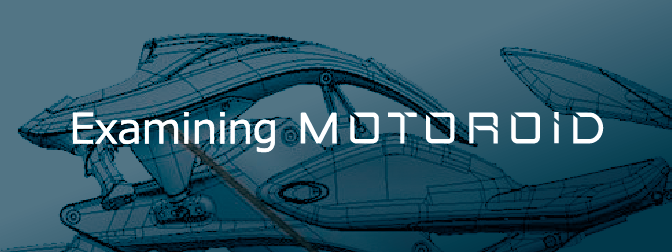“MOTOROiD, stand up!” As if waking from a slumber to respond to the call, the machine’s chassis gyrates and slowly brings itself up off its sidestand to stand upright on its own. With a beckoning gesture or call from the rider, MOTOROiD moves forward, and sometimes rotates its chassis to snake left and right as if engaged in a friendly frolic with the rider. Despite being a human with a machine, the scene looks more like a dog—albeit a very large one—and its owner going for a leisurely stroll, with a sense of intimacy and mutual trust.
The show visitors crowded around the stage were mesmerized by MOTOROiD and their imaginations likely began to run wild: “In the not-so-distant future, we may actually see motorcycles become this advanced.” It was a showstopping sight at the Tokyo Motor Show in 2017.
The primary technologies comprising MOTOROiD are an image recognition AI system for recognizing the rider’s face and gestures, Yamaha’s exclusive AMCES (Active Mass Center Control System) self-balancing technology, and a haptic human-machine interface (HMI) that wraps around the hips and is aimed at fostering non-verbal communication between rider and machine.
Each of these cutting-edge technologies were already being developed independently before MOTOROiD, and the original mission given to the design team was to create a design for the exterior covers of the testbed vehicle for these technologies. The request was for “a machine that looks and acts like a living creature.” It was this idea that would eventually lead to the creation of MOTOROiD as an entirely new kind of vehicle.
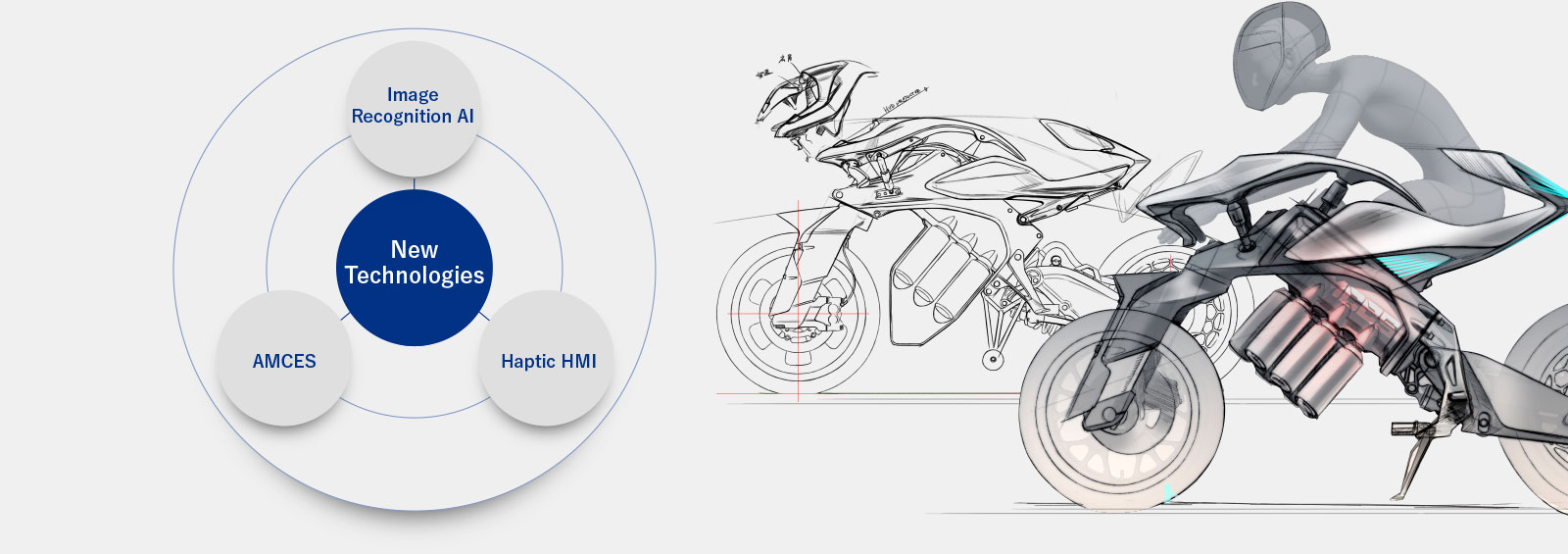
What the development team had in mind for the exterior covers was to convey a more direct, lifelike physical sensation, with a soft but firm feel that seemed like it could emit body heat upon touch. Within the limited amount of time available, the design team searched for the right direction to go in to realize that idea but also sought how to express what made the machine uniquely Yamaha. How would the rider and this all-new “living machine” come together? What would the ride be like and what kind of enjoyment could be found through it? The team eventually arrived at an answer.
They would not simply design some external covers; they would re-conceive the idea of the vehicle as a “testbed” to instead be a motorcycle that moves autonomously in order to create an all-new kind of rider-machine relationship, and thus begin the design process from the layout of the machine itself. They concluded that visually expressing the numerous advanced technologies and features equipped on the bike would be the best way to illustrate the unique style of Yamaha, i.e., the Jin-Ki Kanno* of a next-generation machine.
*Jin-Ki Kanno - The seductive exhilaration felt when one with the machine.
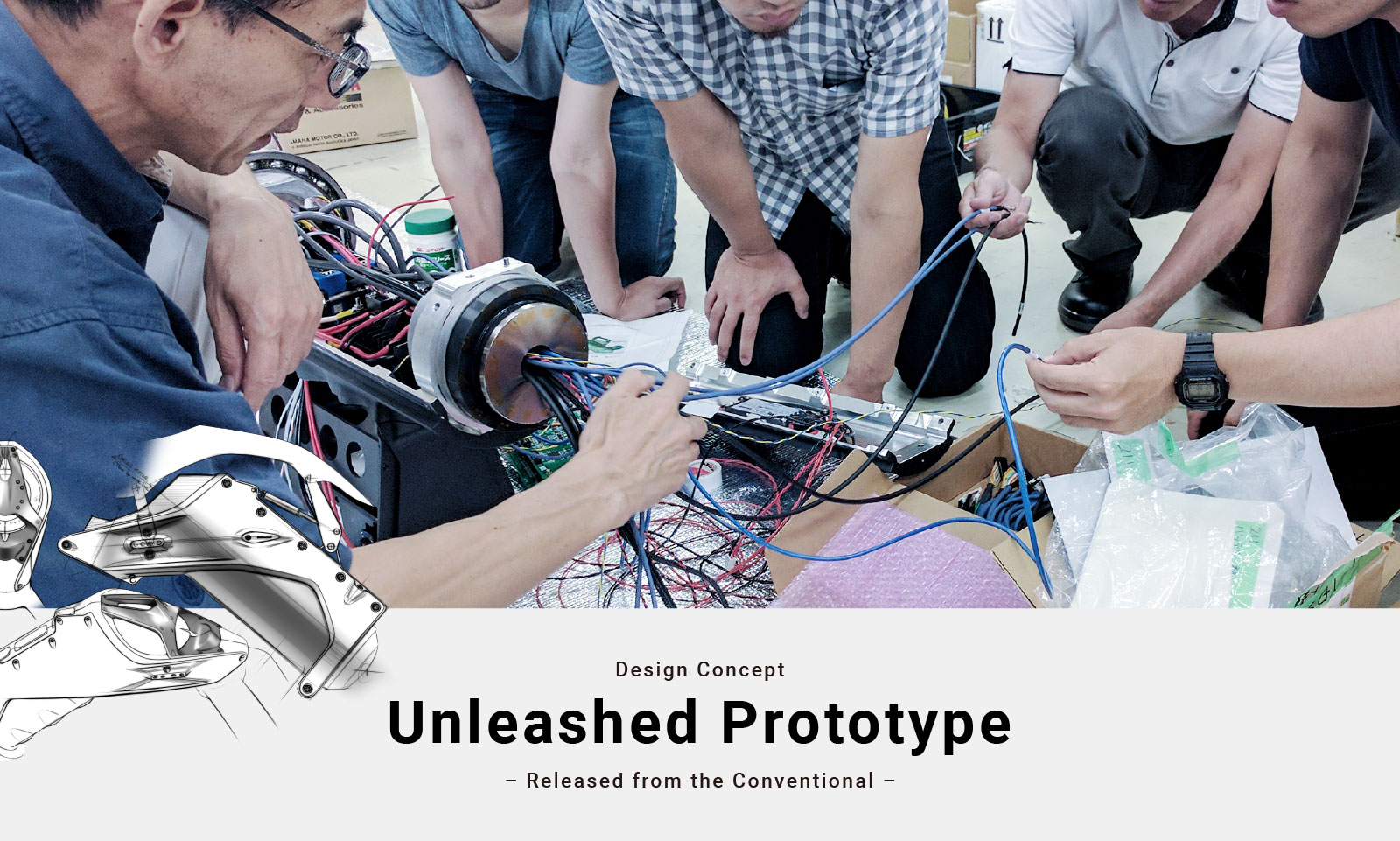
In creating an all-new, unprecedented kind of machine, the design team endeavored to push aside the ideas they originally had for an animal-like shape, pet-like behavior, etc., and reached a shared vision to instead try and optimize the model’s functions and construction into an enchanting form. Rather than simply adding functionality to an existing motorcycle design, they believed creating the ideal shapes for each of the model’s main functions and putting them together would naturally make the machine beautiful to look at as well as uniquely Yamaha.
MOTOROiD was born from such ideals, and despite the team avoiding attempts to duplicate animal-like factors, the model’s unique exterior and movements still ended up having a distinguishable, lifelike quality. In the same way living creatures evolve to develop specialized functions and forms, this was proof that MOTOROiD had also stayed faithful to its intended functions as the design was polished.
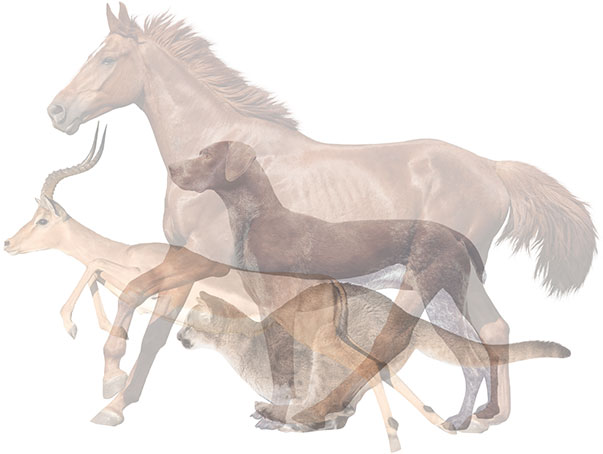
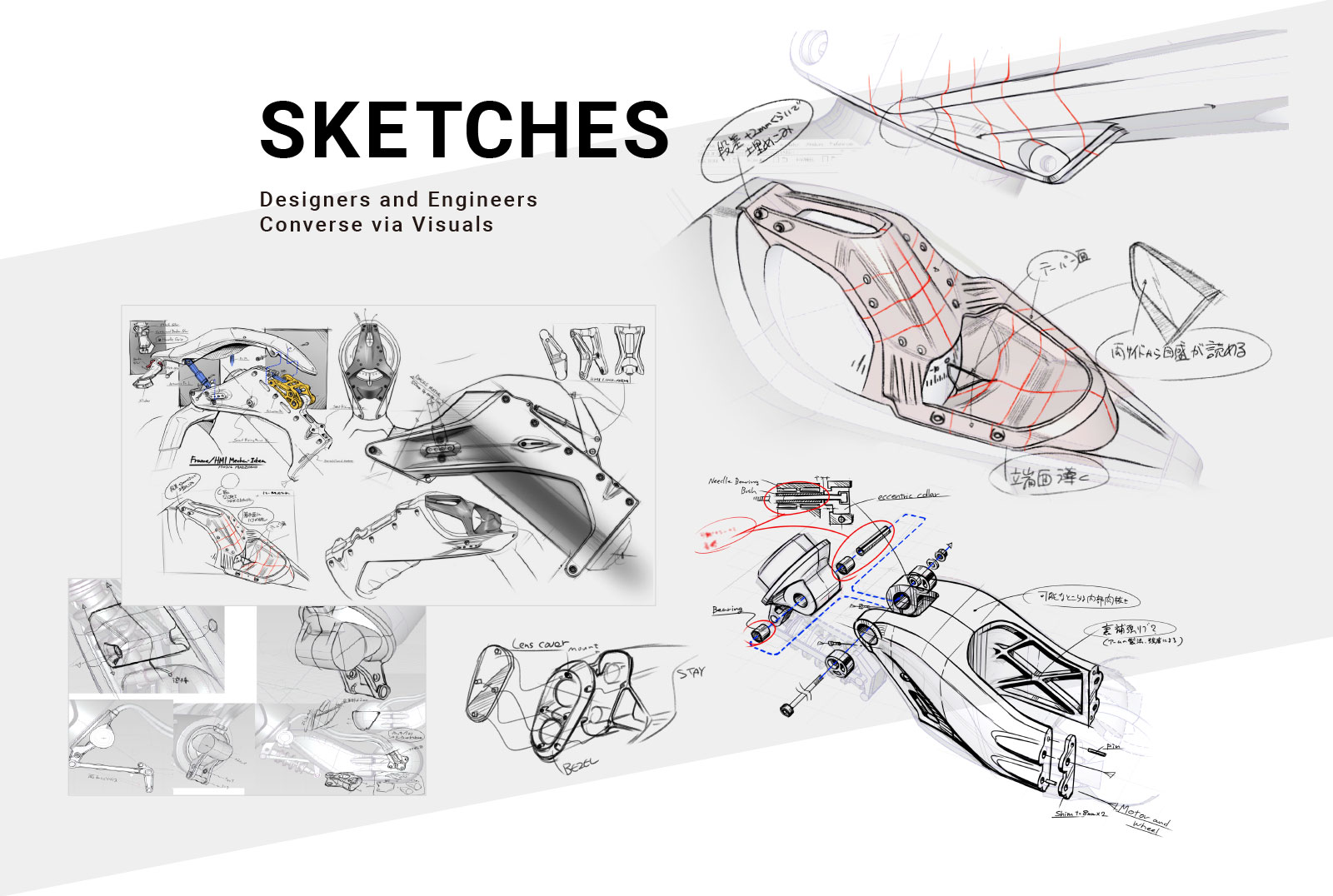
In order to put together this technical testbed as a completely new motorcycle from the ground up, the designers had to assess and select which individual key technologies should be implemented in the design. Each was a cutting-edge technology that Yamaha had spent time and effort developing. However, what could be considered the most important factor in MOTOROiD’s development was how to bring together and package these technologies—even though each mechanism and device had its own unique shape and construction—in a way that would produce the “living machine” feel the project was aiming for.
The design team worked to understand the technical details and mechanical components of the technologies, searching for what the model’s specific shape, form and construction should be. In doing so, the designers used these technical sketches in their dialogues with the engineers. They sketched out the detailed shapes of parts that did not even exist yet in order to visualize them, and then compared the images they had in mind with those the engineers had and made adjustments, thereby leading to developing more concrete ideas.
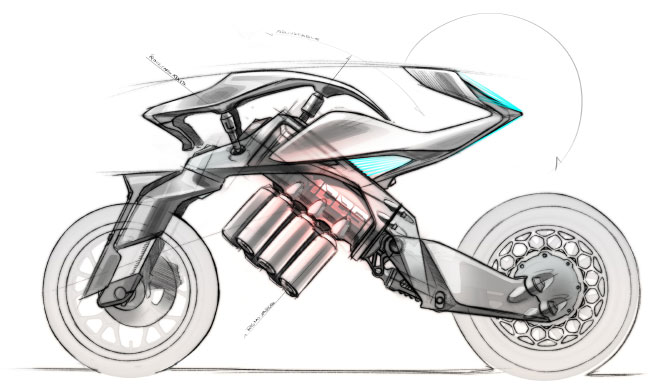
The result of this trial and error process was a single key sketch that formed the basis of MOTOROiD: a next-generation motorcycle that itself housed a self-balancing mechanism. True to the MOTOROiD’s concept of being an “Unleashed Prototype: Released from the Conventional,” this sketch was what ”released” the design and engineering teams from their seemingly endless search for the ideal machine layout and overall image, and gave them a fully shared vision of the direction in which to proceed. From this point, MOTOROiD’s development accelerated at a rapid pace.


In putting together the design for MOTOROiD, the designers needed to gain a deep understanding of the makeup and special characteristics of the model’s self-balancing device, AI-based image recognition of the rider, haptic HMI and other technologies. To that end, the engineers and designers engaged in communication that grew close and frequent as development progressed, fueled—and sometimes hampered—by their passion for the project and love of motorcycles. The result was that the designers would sometimes present mechanisms and frame constructions more practical than the engineers, or the engineers would try to make design sketches technically viable. In effect, a development environment was born with no boundaries dividing the two groups: the engineers were designing and the designers were engineering.
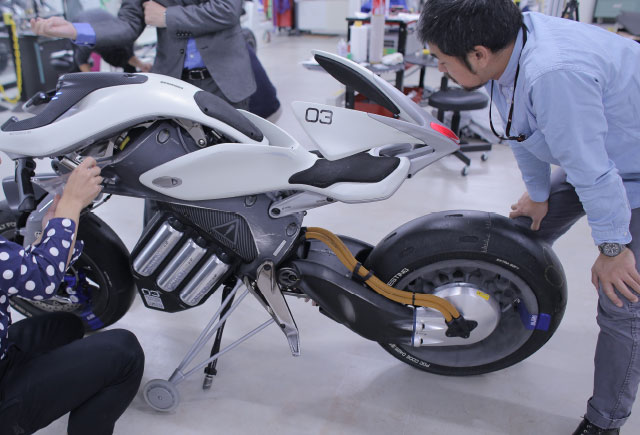
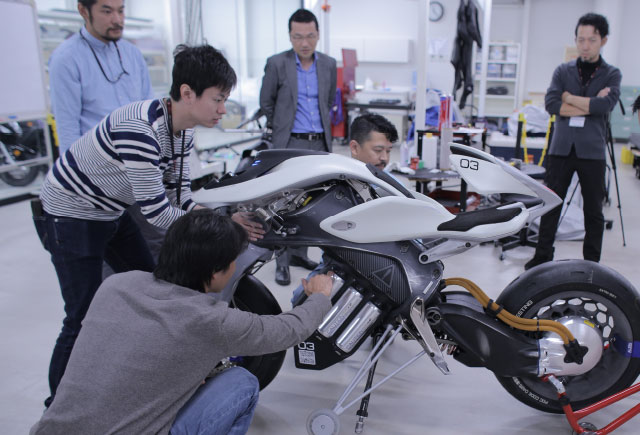
What greatly contributed toward making this closely cooperative work possible was the completion in December of 2016 of Yamaha’s design hub: the Yamaha Motor Innovation Center. The building has a unique architecture, with the 2nd to 4th floor connected by open-air staircases and each floor having few doors or walls, all aimed at encouraging active communication and fostering synergy. The designers and engineers worked on the same floor in a seamless environment where they could see each other’s faces as they developed MOTOROiD together. This resulted in a new, never-before-seen kind of collaboration at Yamaha.
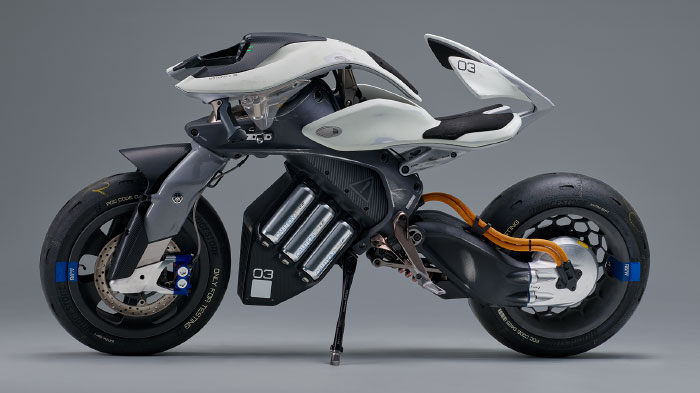
MOTOROiD’s AMCES self-balancing technology was placed at the center of the machine, and the team reconstructed the form of a motorcycle around the model’s ability to stand up and remain upright independently. The battery—the heaviest part of the motorcycle—juts downward from the rotating part of the frame and acts as a counterweight. It also symbolically serves to illustrate how MOTOROiD controls its center of gravity.
Governed by AMCES and the electronics, the movements to continuously control the machine’s center of gravity for balance when it stands up independently were also made to look similar to the way an animal tries to maintain its balance. In particular, the movements needed for MOTOROiD to rise up off its stand are reminiscent of the “preliminary action” seen in the movements living creatures perform unconsciously. Adding this dynamic in as a design element gives MOTOROiD a uniquely lifelike feel.
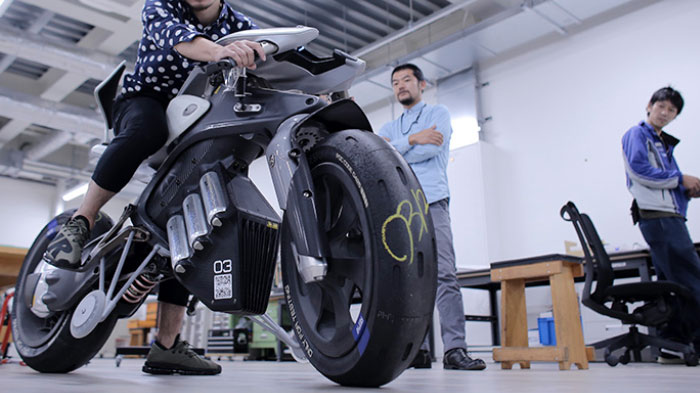
AI-governed image recognition allows MOTOROiD to recognize its owner and his/her hand gestures and respond to them. In addition, a rear haptic contact point envelops the rider’s lower back, aimed at someday providing a physical link to enable non-verbal communication between rider and machine, like the rider’s minute movements and behavior being detected and responded to by the bike itself.
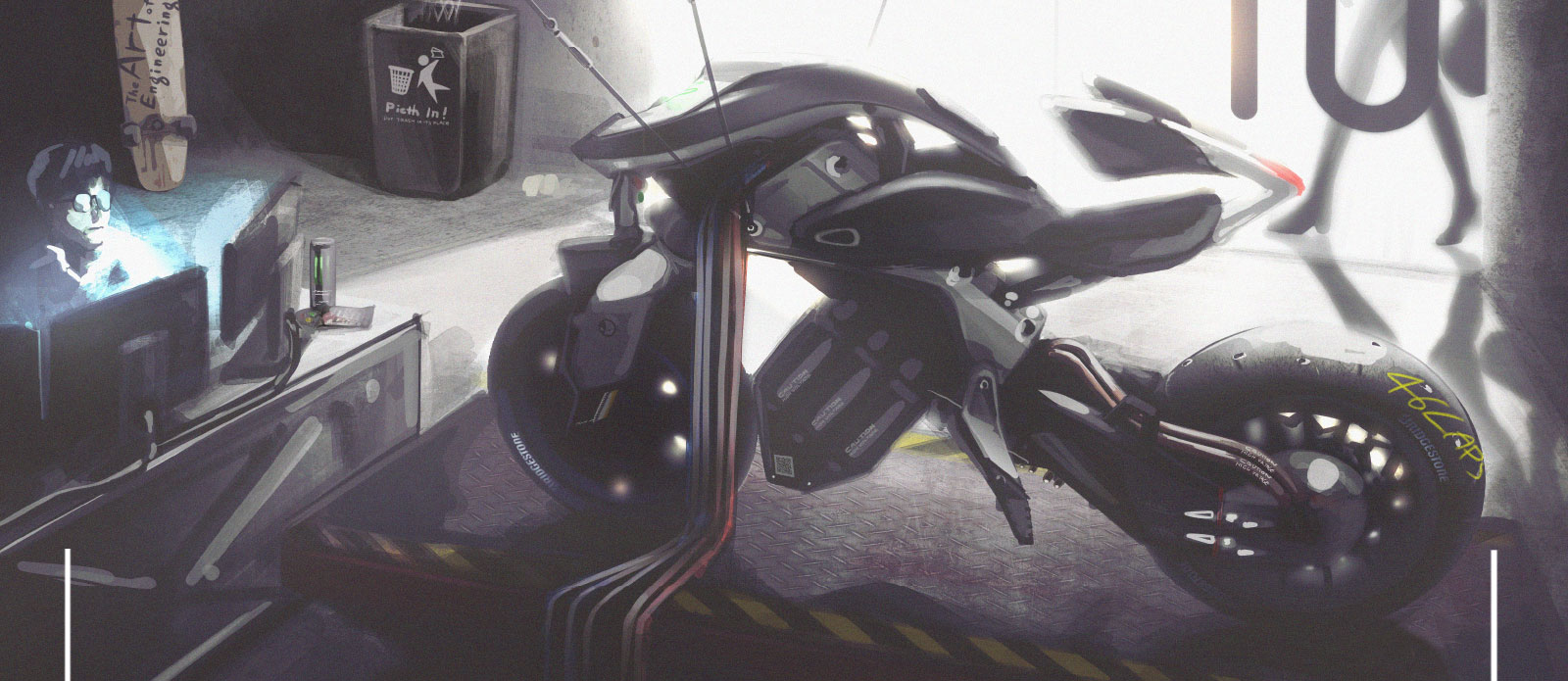
Thanks to next-generation technologies, a motorcycle that can communicate with its rider almost like a living creature has finally appeared. MOTOROiD has the potential to make an array of all-new user experiences possible, like approaching when beckoned with a gesture or sensing the rider’s movements and offering steering support accordingly. When there is mutual understanding and communication between a rider and the machine, the machine transforms from an object into a partner. MOTOROiD has been wholly designed to create that kind of relationship, in not only its colors and shapes but also its functions and movements.
MOTOROiD’s interface to facilitate such user experiences is aimed at deepening Yamaha’s Jin-Ki Kanno ideal and holds the potential to bring it to more users. A rider’s skill has always been a determining factor for experiencing rider-machine unity, but providing more interactive communication and electronic control of the machine can now bring a similar if not the same experience. The principal idea is to someday have the machine support the user—who remains in control—but do so ensuring the rider never actually notices that support, helping to maximize the fun of operating and controlling a motorcycle. Motorcycles of the future could evolve from being objects into partners along for the ride. This is one direction put forward by the designers with MOTOROiD that Yamaha may move toward in the future.
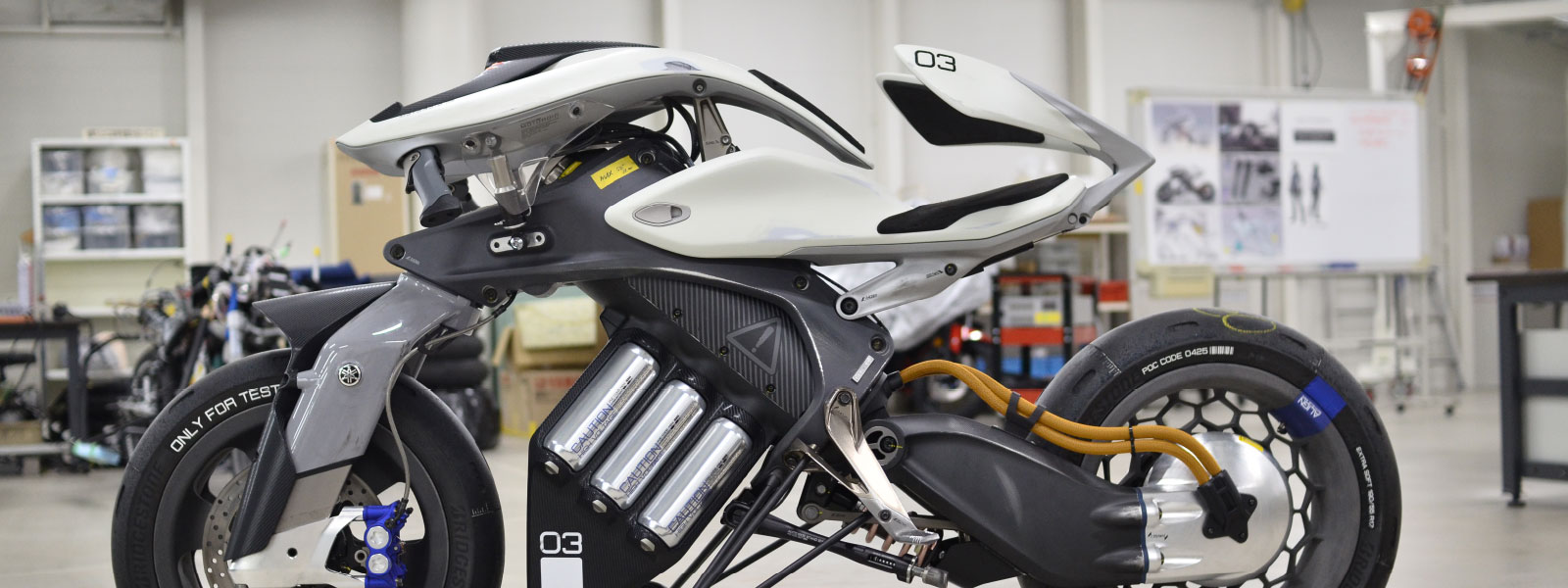
When MOTOROiD was revealed at the Tokyo Motor Show, it drew massive attention and was a prime topic of the show, but it also triggered something rather strange, especially since it is a concept model. People were already searching the internet to see how much it would cost; people were not just asking Yamaha directly, but internet forums had topics with users speculating over what the MOTOROiD’s price would be. Show visitors were also saying things like, “I don’t even have a license yet, but I’d definitely want to ride something like this,” or “I’d love to have some riding support for when I get older.” They surely saw through MOTOROiD what the designers wanted to imbue it with: a real, tangible look at motorcycles of the future. Those who saw MOTOROiD firsthand likely felt the same thing and began painting a picture in their minds of what motorcycling in the future may be like.



